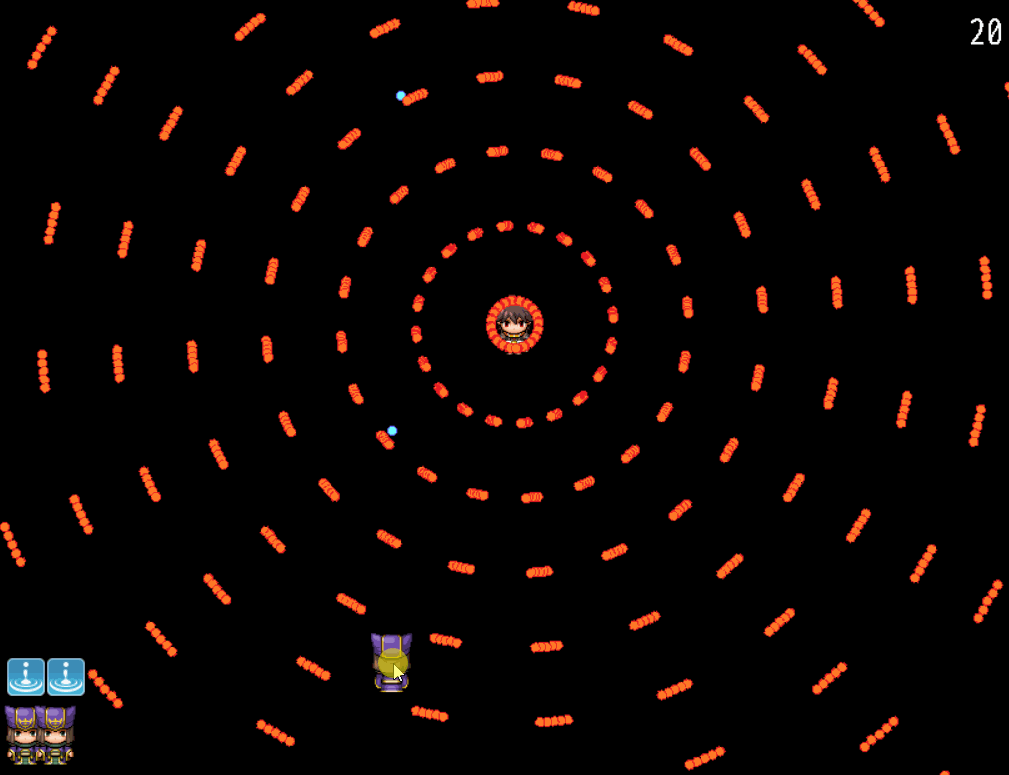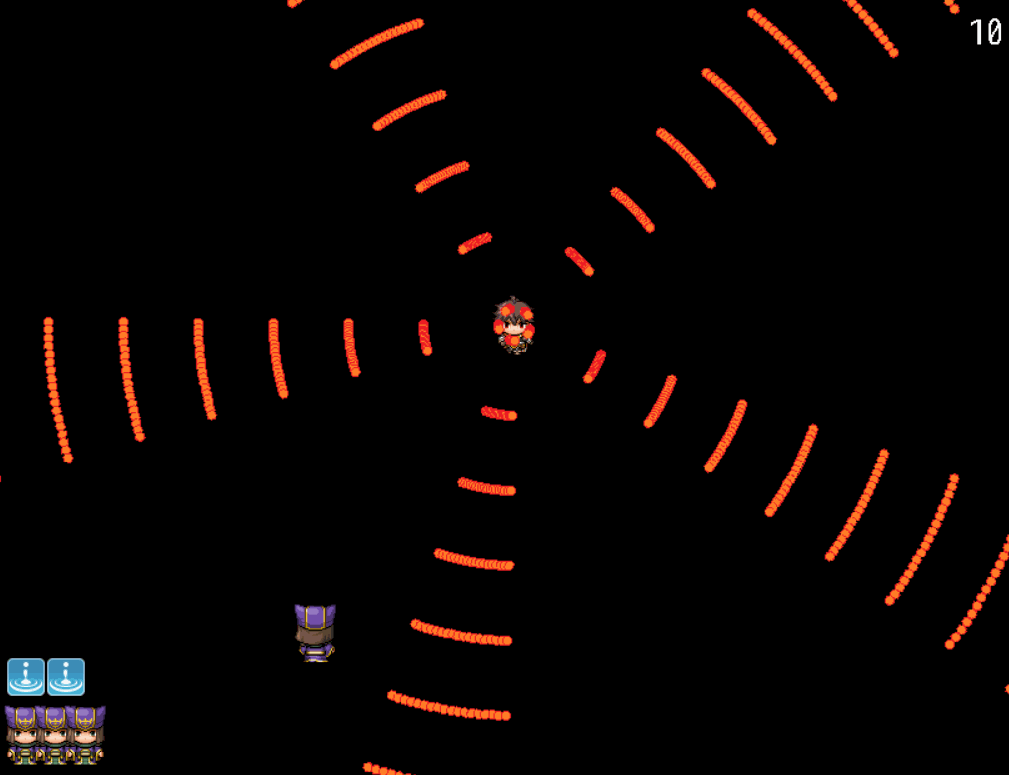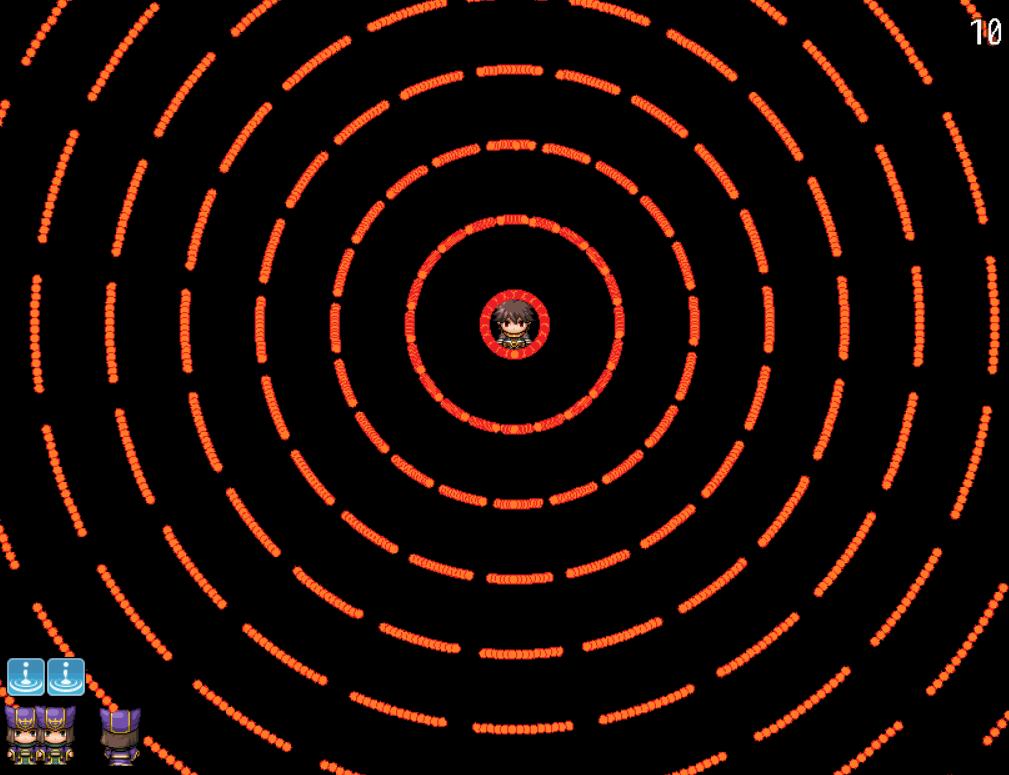In this tutorial we are going to implement two emitter classes, one for exclusive use by the players, the other one for enemies.
The code for the two differs slightly, due to the fact that player's emitters need an additional layer (the BHell.BHell_Emitter_Factory methods) in order to be configured in a general way (while each enemy class can initialise them according to their specific needs).
For player's use we will create an emitter which moves randomly within a radius around the player and then shoots aiming automatically at enemies. For enemies' sake, we will create an emitter shooting a series of equally spaced arcs forming a circle with "spaces" the player can use to dodge the attack.
BHell_Emitter_Probe
The probe enemies can arguably be considered the most annoying ones: they move very quickly in an unpredictable fashion and (with default parameters) shoot aiming at the player.
We want to cast the same nightmare upon the enemies, so we want to create an emitter which will automatically aim at enemies and move randomly around the player.

More precisely we want to implement this two-phases behaviour:
- If in shooting phase, create a bullet for each enemy on screen (aimed at them) and don't move,
- If at the beginning of the moving phase, pick a new destination within a given
radiusfrom the player position, - During the moving phase, move towards the destination and don't shoot.
In terms of configuration we need our emitter to accept the following parameters:
radius: the maximum distance from the player allowed when picking a new destination,speed: the moving speed of the emitter,shooting_frames: the number of frames the emitter should stop and shoot.
Let's start by creating an emitter_probe.js plugin and by reopening our BHell module:
var BHell = (function (my) {
/* Our code will go here */
return my;
}(BHell || {}));
We are going to create a new class extending BHell.BHell_Emitter_Base (since none of the predefined emitters provide something useful for our needs):
var BHell_Emitter_Probe = my.BHell_Emitter_Probe = function () {
this.initialize.apply(this, arguments);
};
BHell_Emitter_Probe.prototype = Object.create(my.BHell_Emitter_Base.prototype);
BHell_Emitter_Probe.prototype.constructor = BHell_Emitter_Probe;
BHell_Emitter_Probe.prototype.initialize = function (x, y, params, parent, bulletList) {
my.BHell_Emitter_Base.prototype.initialize.call(this, x, y, params, parent, bulletList);
};
Let's initialise our class, we need to retrieve the parameters and initialise the following properties:
- position and destination should be set to the player's position (plus the specified offset),
- the initial phase should be set to moving (we define a
stoppedflag set tofalsewhen moving and totruewhen shooting, since ashootingflag is already defined and used byBHell.BHell_Emitter_Base), - we also need a frame counter for our shooting phase.
Our initialisation method looks like this:
BHell_Emitter_Probe.prototype.initialize = function (x, y, params, parent, bulletList) {
my.BHell_Emitter_Base.prototype.initialize.call(this, x, y, params, parent, bulletList);
this.radius = 20;
this.speed = 5;
this.shootingFrames = 60;
if (params != null) {
this.radius = params.radius || this.radius;
this.speed = params.speed || this.speed;
this.shootingFrames = params.shootingFrames || this.shootingFrames;
}
this.x = my.player.x + this.offsetX;
this.y = my.player.y + this.offsetY;
this.destX = this.x;
this.destY = this.y;
this.stopped = false;
this.k = 0;
};
The default BHell.BHell_Emitter_Base#update implementation updates the shooting state every frame, but we want our emitter not to shoot when it's moving, so we need to reimplement it:
BHell_Emitter_Probe.prototype.update = function () {
// Don't forget to update the sprite!
my.BHell_Sprite.prototype.update.call(this);
if (this.stopped) {
if (this.shooting === true) {
if (this.j === 0) {
this.shoot();
}
this.j = (this.j + 1) % this.period;
}
this.oldShooting = this.shooting;
this.k = (this.k + 1) % this.shootingFrames;
if (this.k === 0) {
this.stopped = false;
}
}
};
Our move method will need to deal with a complex behaviour:
- if the player has just spawned follow it (taking the offset into account),
- otherwise if the emitter is not shooting:
- if the emitter is close enough (i.e. two pixels) to the destination, pick a new destination and start shooting,
- otherwise move towards the destination (limiting the space traveled each frame by the emitter's speed).
This is our move method:
BHell_Emitter_Probe.prototype.move = function (x, y) {
if (my.player.justSpawned) {
this.x = my.player.x + this.offsetX;
this.y = my.player.y + this.offsetY;
this.destX = my.player.x + this.offsetX;
this.destY = my.player.y + this.offsetY;
}
if (!this.stopped) {
var dx = this.destX - this.x;
var dy = this.destY - this.y;
if (Math.abs(dx) < 2 && Math.abs(dy) < 2) {
var phi = Math.random() * 2 * Math.PI;
var r = Math.random() * this.radius;
this.destX = x + Math.round(Math.cos(phi) * r) + this.offsetX;
this.destY = y + Math.round(Math.sin(phi) * r) + this.offsetY;
this.stopped = true;
}
else {
var angle = Math.atan2(dy, dx);
if (dx > 0) {
this.x += Math.cos(angle) * Math.min(dx, this.speed);
}
else if (dx < 0) {
this.x += Math.cos(angle) * Math.max(dx, this.speed);
}
if (dy > 0) {
this.y += Math.sin(angle) * Math.min(dy, this.speed);
}
else if (dy < 0) {
this.y += Math.sin(angle) * Math.max(dy, this.speed);
}
}
}
};
The shooting behaviour (enabled only when the emitter is not moving) is the following:
- if there are enemies on screen spawn a bullet aimed at every one of them,
- otherwise (there are no enemies on stage or we are previewing the player in the shop or player selection screens), spawn a bullet aimed at a random direction.
Our shoot method looks like this:
BHell_Emitter_Probe.prototype.shoot = function () {
if (this.stopped) {
if (my.controller != null && my.controller.enemies != null) {
for (var l = 0; l < my.controller.enemies.length; l++) {
var enemy = my.controller.enemies[l];
var angle = Math.atan2(enemy.y - this.y, enemy.x - this.x);
var bullet = new my.BHell_Bullet(this.x, this.y, angle, this.bulletParams, this.bulletList);
this.parent.addChild(bullet);
this.bulletList.push(bullet);
}
}
else {
var angle = Math.random() * 2 * Math.PI;
var bullet = new my.BHell_Bullet(this.x, this.y, angle, this.bulletParams, this.bulletList);
this.parent.addChild(bullet);
this.bulletList.push(bullet);
}
}
};
If we were dealing with an enemy emitter, we could stop here and equip an enemy class with it, but for player's use we need to do something more.
Player's emitters are parsed by BHell.BHell_Emitter_Factory, which takes care of properly parsing parameters and, most importantly, to implement the ranking mechanics for the emitters (i.e. the rate rank will modify the emitter's period, while the power rank will determine if the emitter should be created or not).
To allow our players to use our BHell_Emitter_Probe, we need to extend BHell.BHell_Emitter_Factory.create so that it will return an instance of our emitter when it receives an emitter.type parameter equal to "probe".
Since this method is static, we need to extend it by saving the previous implementation in a variable and then call it from the new method:
var _Emitter_Factory_Create = my.BHell_Emitter_Factory.create;
my.BHell_Emitter_Factory.create = function (emitter, x, y, w, h, params, parent, bulletList) {
var ret = _Emitter_Factory_Create.call(this, emitter, x, y, w, h, params, parent, bulletList);
if (ret == null && emitter.type === "probe") {
params.speed = my.parse(emitter.params.speed, x, y, w, h, Graphics.width, Graphics.height);
params.radius = my.parse(emitter.params.radius, x, y, w, h, Graphics.width, Graphics.height);
params.shootingFrames = my.parse(emitter.params.shooting_frames, x, y, w, h, Graphics.width, Graphics.height);
ret = new my.BHell_Emitter_Probe(x, y, params, parent, bulletList);
}
return ret;
};
Our emitter_probe.js is now complete:
var BHell = (function (my) {
var _Emitter_Factory_Create = my.BHell_Emitter_Factory.create;
my.BHell_Emitter_Factory.create = function (emitter, x, y, w, h, params, parent, bulletList) {
var ret = _Emitter_Factory_Create.call(this, emitter, x, y, w, h, params, parent, bulletList);
if (ret == null && emitter.type === "probe") {
params.speed = my.parse(emitter.params.speed, x, y, w, h, Graphics.width, Graphics.height);
params.radius = my.parse(emitter.params.radius, x, y, w, h, Graphics.width, Graphics.height);
params.shootingFrames = my.parse(emitter.params.shooting_frames, x, y, w, h, Graphics.width, Graphics.height);
ret = new my.BHell_Emitter_Probe(x, y, params, parent, bulletList);
}
return ret;
};
var BHell_Emitter_Probe = my.BHell_Emitter_Probe = function () {
this.initialize.apply(this, arguments);
};
BHell_Emitter_Probe.prototype = Object.create(my.BHell_Emitter_Base.prototype);
BHell_Emitter_Probe.prototype.constructor = BHell_Emitter_Probe;
BHell_Emitter_Probe.prototype.initialize = function (x, y, params, parent, bulletList) {
my.BHell_Emitter_Base.prototype.initialize.call(this, x, y, params, parent, bulletList);
this.radius = 20;
this.speed = 5;
this.shootingFrames = 60;
if (params != null) {
this.radius = params.radius || this.radius;
this.speed = params.speed || this.speed;
this.shootingFrames = params.shootingFrames || this.shootingFrames;
}
this.x = my.player.x + this.offsetX;
this.y = my.player.y + this.offsetY;
this.destX = this.x;
this.destY = this.y;
this.stopped = false;
this.k = 0;
};
BHell_Emitter_Probe.prototype.update = function () {
my.BHell_Sprite.prototype.update.call(this);
if (this.stopped) {
if (this.shooting === true) {
if (this.j === 0) {
this.shoot();
}
this.j = (this.j + 1) % this.period;
}
this.oldShooting = this.shooting;
this.k = (this.k + 1) % this.shootingFrames;
if (this.k === 0) {
this.stopped = false;
}
}
};
BHell_Emitter_Probe.prototype.move = function (x, y) {
if (my.player.justSpawned) {
this.x = my.player.x + this.offsetX;
this.y = my.player.y + this.offsetY;
this.destX = my.player.x + this.offsetX;
this.destY = my.player.y + this.offsetY;
}
if (!this.stopped) {
var dx = this.destX - this.x;
var dy = this.destY - this.y;
if (Math.abs(dx) < 2 && Math.abs(dy) < 2) {
var phi = Math.random() * 2 * Math.PI;
var r = Math.random() * this.radius;
this.destX = x + Math.round(Math.cos(phi) * r) + this.offsetX;
this.destY = y + Math.round(Math.sin(phi) * r) + this.offsetY;
this.stopped = true;
}
else {
var angle = Math.atan2(dy, dx);
if (dx > 0) {
this.x += Math.cos(angle) * Math.min(dx, this.speed);
}
else if (dx < 0) {
this.x += Math.cos(angle) * Math.max(dx, this.speed);
}
if (dy > 0) {
this.y += Math.sin(angle) * Math.min(dy, this.speed);
}
else if (dy < 0) {
this.y += Math.sin(angle) * Math.max(dy, this.speed);
}
}
}
};
BHell_Emitter_Probe.prototype.shoot = function () {
if (this.stopped) {
if (my.controller != null && my.controller.enemies != null) {
for (var l = 0; l < my.controller.enemies.length; l++) {
var enemy = my.controller.enemies[l];
var angle = Math.atan2(enemy.y - this.y, enemy.x - this.x);
var bullet = new my.BHell_Bullet(this.x, this.y, angle, this.bulletParams, this.bulletList);
this.parent.addChild(bullet);
this.bulletList.push(bullet);
}
}
else {
var angle = Math.random() * 2 * Math.PI;
var bullet = new my.BHell_Bullet(this.x, this.y, angle, this.bulletParams, this.bulletList);
this.parent.addChild(bullet);
this.bulletList.push(bullet);
}
}
};
return my;
}(BHell || {}));
We are now ready to attach this emitter to a player in our JSON:
{
"type": "probe",
"params": {
"x": 0,
"y": -50,
"period": 120,
"radius": 50,
"ranks": ["S"],
"shooting_frames": 60,
"speed": 4,
"sprite": "$Helpers",
"index": 0,
"direction": 2,
"animated": false,
"bullet": {
"sprite": "$Bullets",
"index": 0,
"direction": 2,
"frame": 1,
"speed": 9,
"animated": false
}
}
}
Note: Due to its random movements, it's highly recommended to always use this emitter with a sprite, so the player will always know where the emitter is.
Important: This emitter aims at the enemies, it would be therefore stupid to equip an enemy with it (unless you are planning on creating a BHell_Enemy_Traitor class).
BHell_Emitter_Circle
In this part of the tutorial we want to create a BHell_Emitter_Circle, capable of shooting a ring of bullets. To make the ring dodgeable, we want it to alternate arcs with actual bullets and empty arcs, like the following:

We also want our emitter to be customisable in terms of how wide our arcs are and how many of them are going to be shot.
To achieve this result, let's divide our circle into pulses. Unlike the previous image (which had 20 pulses), the following has only 5:

Another parameter we can customise is the duty_cycle, intended as the percentage of pulse which should have bullets in it. The following image has a 0.8 duty_cycle (80%), instead of 0.25 of the first image (while they both have 20 pulses each):

What we are going to do is to divide each pulse into two parts:
- the first one being filled with bullets (let's call it the
onpart), - the latter being empty (let's call it the
offpart).
When the aim flag is set to true, we want the on part of the first pulse to be centered at the player's position.
Just like BHell.BHell_Emitter_Angle, BHell.BHell_Emitter_Spray and BHell.BHell_Emitter_Burst, we also want to define the parameters always_aim, aim_x and aim_y which work in a similar fashion:
always_aim: iftruekeeps aiming at the player at every shot (iffalseaiming is done only when an enemy callsBHell.BHell_Enemy_Base#shootwithfalse, followed by a call withtrue),aim_x: moves the aim x coordinate away from the player,aim_y: moves the aim y coordinate away from the player.
Finally we want an additional flag, which we'll call invert, capable of inverting the other parameter's behaviour (e.g. if we are aiming towards the player, the off part will be centered and the actual duty cycle will be 1 - duty_cycle).
Let's now create an emitter_circle.js plugin, with our BHell_Emitter_Circle class:
var BHell = (function (my) {
var BHell_Emitter_Circle = my.BHell_Emitter_Circle = function () {
this.initialize.apply(this, arguments);
};
BHell_Emitter_Circle.prototype = Object.create(my.BHell_Emitter_Base.prototype);
BHell_Emitter_Circle.prototype.constructor = BHell_Emitter_Circle;
BHell_Emitter_Circle.prototype.initialize = function (x, y, params, parent, bulletList) {
my.BHell_Emitter_Base.prototype.initialize.call(this, x, y, params, parent, bulletList);
};
return my;
}(BHell || {}));
We need to initialise our parameters, and an additional variable, required for aiming purposes:
n: the number of bullets we want to spawn in our circle,duty_cycle: the percentage of circle which will be filled with bullets,pulses: how many arcs should the circle be divided into,invert: whether theonandoffparts of each pulse should be inverted,aim: iftrueaims towards the player,always_aim: iftruerecalculates the aiming angle every time,aim_x: aiming x offset,aim_y: aiming y offset,aimingAngle: required for storing the angle between shots ifaimis set totruebutalways_aimis set tofalse.
Our initialisation method looks like this:
BHell_Emitter_Circle.prototype.initialize = function (x, y, params, parent, bulletList) {
my.BHell_Emitter_Base.prototype.initialize.call(this, x, y, params, parent, bulletList);
this.n = 360;
this.dutyCycle = 0.25;
this.pulses = 20;
this.invert = false;
this.aim = false;
this.alwaysAim = false;
this.aimX = 0;
this.aimY = 0;
this.aimingAngle = 0;
if (params != null) {
this.n = params.n || this.n;
this.dutyCycle = params.duty_cycle || this.dutyCycle;
this.pulses = params.pulses || this.pulses;
this.invert = params.invert || this.invert;
this.aim = params.aim || this.aim;
this.alwaysAim = params.always_aim || this.alwaysAim;
this.aimX = params.aim_x || this.aimX;
this.aimY = params.aim_y || this.aimY;
}
};
If we are shooting with duty_cycle = 1 (100%), our circle will contain exactly n bullets, fired with a 2 * Math.PI / n angle between each other.
To achieve a different duty cycle, we need to "erase" some of those bullets (obtaining an actual number of bullets on screen less than n, e.g. for a 40% duty cycle we would have n * 0.4 bullets and n * 0.6 "empty spaces").
Since we want our bullets to be evenly spaced, we divide our on and off areas into pulses, each one containing pulseWidth = n / pulses "slots", with only dutyCount = pulseWidth * dutyCycle bullets in them (and therefore pulseWidth - dutyCount "empty spaces" after the bullets).
If the invert flag is not set, we want the first part (following our arc in a clockwise fashion) of each pulse to contain our bullets, otherwise (if the invert flag is set), we want the second part. The xor (^) operator can allow us to shorten our condition a little.
To "center" our ring in the middle of the on part of the first pulse, we need to rotate counterclockwise every angle by 2 * Math.PI / (dutyCount / 2).
BHell_Emitter_Circle.prototype.shoot = function () {
var pulseWidth = Math.round(this.n / this.pulses);
var dutyCount = Math.round(this.dutyCycle * pulseWidth);
for (var k = 0; k < this.n; k++) {
if (((k % pulseWidth) < dutyCount) ^ this.invert) {
var bullet;
if (this.aim) {
if (this.alwaysAim || this.oldShooting === false) {
var dx = my.player.x - this.x + this.aimX;
var dy = my.player.y - this.y + this.aimY;
this.aimingAngle = Math.atan2(dy, dx);
}
bullet = new my.BHell_Bullet(this.x, this.y, this.aimingAngle - Math.PI + 2 * Math.PI / this.n * (k - dutyCount / 2), this.bulletParams, this.bulletList);
}
else {
bullet = new my.BHell_Bullet(this.x, this.y, 2 * Math.PI / this.n * (k - dutyCount / 2), this.bulletParams, this.bulletList);
}
this.parent.addChild(bullet);
this.bulletList.push(bullet);
}
}
};
Our complete BHell_Emitter_Circle looks like this:
var BHell = (function (my) {
var BHell_Emitter_Circle = my.BHell_Emitter_Circle = function () {
this.initialize.apply(this, arguments);
};
BHell_Emitter_Circle.prototype = Object.create(my.BHell_Emitter_Base.prototype);
BHell_Emitter_Circle.prototype.constructor = BHell_Emitter_Circle;
BHell_Emitter_Circle.prototype.initialize = function (x, y, params, parent, bulletList) {
my.BHell_Emitter_Base.prototype.initialize.call(this, x, y, params, parent, bulletList);
this.n = 360;
this.dutyCycle = 0.25;
this.pulses = 20;
this.invert = false;
this.aim = false;
this.alwaysAim = false;
this.aimX = 0;
this.aimY = 0;
this.aimingAngle = 0;
if (params != null) {
this.n = params.n || this.n;
this.dutyCycle = params.duty_cycle || this.dutyCycle;
this.pulses = params.pulses || this.pulses;
this.invert = params.invert || this.invert;
this.aim = params.aim || this.aim;
this.alwaysAim = params.always_aim || this.alwaysAim;
this.aimX = params.aim_x || this.aimX;
this.aimY = params.aim_y || this.aimY;
}
};
BHell_Emitter_Circle.prototype.shoot = function () {
var pulseWidth = Math.round(this.n / this.pulses);
var dutyCount = Math.round(this.dutyCycle * pulseWidth);
for (var k = 0; k < this.n; k++) {
if (((k % pulseWidth) < dutyCount) ^ this.invert) {
var bullet;
if (this.aim) {
if (this.alwaysAim || this.oldShooting === false) {
var dx = my.player.x - this.x + this.aimX;
var dy = my.player.y - this.y + this.aimY;
this.aimingAngle = Math.atan2(dy, dx);
}
bullet = new my.BHell_Bullet(this.x, this.y, this.aimingAngle - Math.PI + 2 * Math.PI / this.n * (k - dutyCount / 2), this.bulletParams, this.bulletList);
}
else {
bullet = new my.BHell_Bullet(this.x, this.y, 2 * Math.PI / this.n * (k - dutyCount / 2), this.bulletParams, this.bulletList);
}
this.parent.addChild(bullet);
this.bulletList.push(bullet);
}
}
};
return my;
}(BHell || {}));
Note: If we wanted, we could make this emitter available for the player as well. To achieve this, we simply need to extend BHell.BHell_Emitter_Factory.create like we did in the previous example.